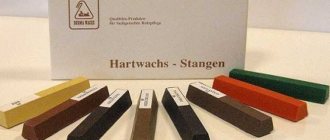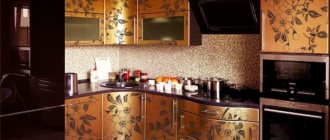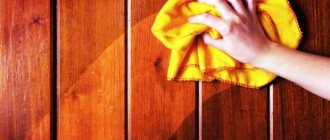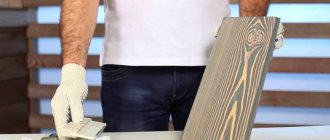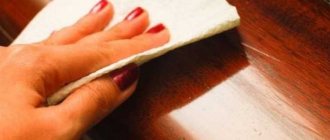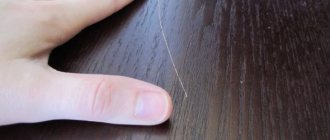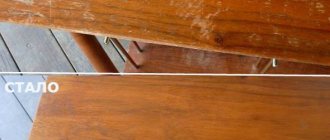0
49384
Wooden furniture can create an atmosphere of comfort and warmth in any interior. During operation, furniture sets are subject to wear and tear, causing small cracks and chips to appear on the surface of the items. If you see such a defect on your favorite table or cabinet, don’t be upset - furniture wax will come to the rescue. To find out how this product is used, you should understand its properties, application, and varieties.
Wax for furniture: description, how to use
From time immemorial, craftsmen covered wooden furniture with wax.
Thus, the wood received protection from various external influences. At the same time, she retained her natural beauty and warmth. Our ancestors also knew about the water-repellent properties of this product. Today, a fairly large number of wood processing options are known. But furniture wax retains its leading position. It is often used to preserve and emphasize the natural beauty of a wooden surface.
How to use wax pencil for furniture
Some problems require a special solution. If the place for restoration is difficult to access or requires small tools, then a special wax pencil will be required. The question arises - where to buy such a pencil for furniture? You can purchase it in hardware stores and construction supermarkets, but if such outlets are not available in your locality, you can always use online stores.
How to use a furniture pencil? Before use, warm it with the warmth of your hand, and then rub it into the desired place without strong pressure.
Benefits of use
Wax, unlike other types of protective agents, completely penetrates the structure of the wood and does not lie on the surface. Thus, the wood does not lose its texture and retains natural warmth. Furniture coated with this product can withstand long-term loads perfectly. This product has other advantages:
- The velvety quality of the material will remain, which is so lacking in polished furniture.
- Cabinets, chairs, tables and chests of drawers made of natural wood will become even more beautiful if they are coated with wax. Under the invisible coating of the protective layer, not only the texture appears, but also the color of the surface of the product becomes more expressive.
- Using a tinted type of material, you can create furniture that fits perfectly into the desired interior.
- Furniture wax is an excellent restoration product. The thick plastic mass fills any cracks, scratches and chips well and helps restore the original appearance of the headset.
The right shade will not only restore household items, but also make them even more beautiful. Furniture polish with wax is also an excellent restoration product.
Wax coated furniture: pros and cons
Furniture wax does not remain on the surface, but penetrates into the structure of wood or other wood-based materials. It does not spoil the texture, but at the same time it saturates the pores of the wood, repelling moisture and reducing the rate of destruction of the material. Other benefits of using wax:
- pleasant to the touch velvety coating after the product dries;
- enhancing color and expressiveness of the design;
- the presence of different shades, the ability to change the natural tone of the item;
- Reliable filling of all defects - chips, cracks, scratches.
There are few downsides to such funds. Compared to varnishes, waxes have less protective power, and their layer will have to be renewed more often. Some species deteriorate from ultraviolet radiation and fade, so restoration work will need to be carried out regularly.
Sources
https://mebel-sovet.ru/dekorirovanie/358-vosk
https://drevogid.com/zashhita/zash-dereva/vosk-dlya-mebeli.html
https://www.liveinternet.ru/users/4766317/post306299867
https://kraska.guru/specmaterialy/zashhita-drevesiny/mebelnyj-vosk.html
Types of wax
In stores you can see a large selection of different options for furniture wax. The following types are distinguished:
- Soft wax for furniture. Experts recommend using it for interior woodwork. This type of polish is great for restoring surfaces and removing chips, cracks, scratches and dents. It is also used for working with both wooden and laminated surfaces. Wooden panels of cabinet furniture and interior doors coated with soft wax perfectly withstand various physical loads. They maintain their integrity under the influence of high humidity and sudden temperature changes. The wax does not require pre-mixing; it is immediately ready for use. The mixture is applied to the required area using a special plastic spatula. Excess is removed with the same tool. If a specific color background is required, wax of different shades can be easily mixed.
- Hard wax for furniture can be used for both external and internal work. It fits perfectly on wood, not only protecting it from negative external factors, but also restores the damaged surface, repairing chips, dents, scratches and cracks. Unlike its soft counterpart, this wax for furniture restoration has a more dense structure. To work with the hard type of polish, a soldering iron is required. The wax is pre-melted using this device. And the already melted mass is applied to the desired area. After a few seconds, he grabs onto the tree. Excess material is removed with a plastic or rubber spatula.
What is a furniture wax pencil used for?
The standard composition of wood wax includes a natural base, various resins, oils and other components. There are many types of products produced by manufacturers. For different types of work, soft material in a package, hard material in a briquette, or a wax pencil are used. How to use a wax pencil for furniture is described below. It is used for retouching scratches and other small work.
We recommend: What is a ventilation anemostat: types of diffusers and their features
How to properly apply wax to furniture with your own hands?
The work of treating wooden surfaces with wax will not be difficult if you study some rules in advance:
- We prepare the surface correctly. In order for furniture wax to be evenly absorbed into the structure of the wood, the pores of the wood must be open. If the furniture has just been assembled and its surface has not been treated with any paints and varnishes, no preliminary preparation is required. It’s more difficult if the furniture is already varnished. In this case, before applying wax polish, the surface must be treated with a solvent. This procedure will have to be carried out several times until all varnish particles are completely removed. After this, the wooden surfaces are treated with sandpaper. Important: work is carried out only in the direction of the fibers. The end result should be a perfectly flat surface.
- Apply furniture wax correctly. The consistency that the wax has is very important. Depending on its type, the work may require certain devices and tools. The liquid type of polish is rubbed in using a thick cloth with even movements in the direction of the wood grain. In some cases, you can use a brush or brush. For thicker wax, use a rubber or plastic spatula. Important: no matter what type of wax is used in the work, the wood must be left for at least an hour after treatment. After which the excess is removed. If the product is applied in one layer, the surface will remain matte. To achieve a glossy shine, it must be applied a second time.
Instructions for use
Depending on the composition of the wax, there are different ways to use it on furniture. For example, to treat small scratches, it is enough to use a material in the form of a pencil.
To do this, you do not need to pre-clean the exterior.
Sometimes the material needs to be melted and poured into the crack to treat damaged wood. To do this, use a micro-soldering iron or hair dryer, or, at worst, a lighter or gas burner.
The product is heated, poured into the crack, leveled with a spatula, and the residue is removed with a soft cloth. If there is an extra layer left, carefully remove it with a dull knife.
To work with a soft structure, you will need to first clean the surface of dirt and previous varnish.
The exterior is cleaned, all wood pores are opened. To clean the pores, use a solvent, wash the recesses with it and dry it. To ensure that the composition is well absorbed, work on the surface with sandpaper.
The following actions with furniture are:
- After opening the package with a sharp knife, carefully scoop out a certain amount of the mixture with a spatula;
- apply the mixture to the site of a crack or other damage, removing excess and rubbing the material with felt;
- remove excess with a spatula or knife and allow time to dry;
- Re-rub the exterior for greater smoothness.
Making your own furniture wax
Some craftsmen use their own preparation in their work. The recipe is quite simple. To make it yourself, combine beeswax with turpentine. Consider the fact that the first component, as a rule, has rich shades of yellow. Therefore, for light-colored furniture you should use light-colored material.
The mixture is prepared in a water bath. Beeswax is crushed with a knife and placed in a jar of turpentine. The last component will need half as much as the first. The saucepan with the contents is placed in a water bath. After our main ingredient has melted, remove the container from the heat. Add the remaining wax little by little to the molten mass until a homogeneous thick mass is obtained.
Characteristic
There are several types of wax. It can be soft or hard. You can prepare the product yourself.
This wax is used only for restoring furniture. It is used if the material has a lot of scratches, cracks, chips and abrasions.
Soft
This type of furniture wax is recommended for use if the damage is deep. The soft composition ideally masks chips and will save you from deep scratches.
It does not need to be diluted or mixed with any substance. Bought it in a store and use it in the same form to hide damage.
How to use wax:
- Put on gloves and take a plastic spatula.
- Apply the product to the desired areas with a spatula so that not a trace remains of scratches.
- Use it to remove any remaining substance. Level the surface.
- The soft composition dries in 20 minutes. After this time, all that remains is to polish the furniture.
To keep tables and cabinets in proper shape, they should be varnished after the wax has completely dried.
If the damage is deep, apply the product in several layers. Each of them must be thoroughly dried before being polished and varnished.
You can use soft wax simply to renew wooden material. It is used for the restoration of cabinets, bedside tables, tables and even for flooring, for example, laminate.
Solid
If the house is undergoing renovation in full swing, and in the process of moving furniture you notice scratches appearing on it or on the floor, do not wait, and immediately get rid of them using hard wax.
- It does an excellent job of removing scratches.
- Perfectly masks minor abrasions.
- It also restores serious defects.
Wax pencils are easier to use than soft mixture. They are sold in different colors, so choosing the right product will not be difficult.
Be sure to wear gloves when using them. Substances used to make wax crayons can adversely affect the skin of your hands, causing serious rashes or redness.
Don't throw away the leftovers, but save them. If stored correctly, they can still be used.
How to use wax crayons for furniture:
- Melt it down. To do this, use a soldering iron, a gas torch or a regular lighter.
- Then cool a little so that the adhesion to wooden furniture is better and immediately apply to the damaged area.
- Remove any remaining product with a utility knife or plastic spatula.
- Wait for it to dry and paint the surface with varnish.
Wax pencil is easy to use but is more expensive than the soft stuff. There are no other differences.
There is also another remedy. It comes in the form of crayons that are sold in hardware stores. They can be oval or rectangular. They are the easiest to use because you don't need to melt them. With crayons they simply paint over the damaged surface and varnish it. They are sold in different colors.
Kinds
There are several types of furniture wax. Each of them has its own purpose, this should be taken into account when choosing a composition. All important information is contained on the packaging.
- Soft. This composition is similar in consistency to Vaseline; it perfectly emphasizes the texture of wood, gives the surface a matte shine, and is used not only for processing furniture. Wax mastics are used to rub parquet and laminate flooring. Soft wax can fill even deep areas of damage and can mask significant chips and cracks.
- Solid. Furniture products are produced in the form of bars, cylinders, and sometimes resemble wax pencils or crayons for drawing. They can be used without heating or require preheating. This wax is designed to seal cracks and mask chips; it is more resistant to mechanical stress and can make damaged areas completely invisible.
- Liquid. The compositions penetrate perfectly into the fibers of the surface being treated, dry within two hours, and are applied with a brush. They update the appearance, mask scratches, and protect the wood from moisture. Liquid wax is not intended for the restoration of products, but for the care of furniture.
Scope of application of furniture edges, product types
The manufacturer must indicate on the packaging exactly how the composition should be used. In order not to be disappointed with the result, you must strictly follow the instructions.
For minor repairs, it is most convenient to use wax pencils for furniture; they do not need to be heated.
Liquid
Soft
Solid
Do it yourself
You can make this product yourself. The procedure requires care and caution, but overall it is not difficult. The main thing is to follow the algorithm of actions and do everything in accordance with the instructions.
How to make your own furniture wax - step by step guide:
- To prepare the product, you only need two ingredients - beeswax and turpentine. The first can be found on the market or bought from a beekeeper, the second is sold in a pharmacy and costs a penny.
- The mixture is prepared in a water bath. First you need to grind the beeswax and place it in a container that already contains turpentine. The ratio is 2:1, but you only need to add 1 part of the wax to the saucepan, the second at the end.
- Place the container with both ingredients in a water bath and wait until it is completely melted. When this happens, immediately remove the pan from the heat. Add the second part of the wax, stir until it melts.
The result should be a homogeneous thick mass. There should be no lumps. If, when you add the wax again, it does not melt completely, keep the saucepan with the mixture a little longer in the steam bath.
Alternative options
If you don’t have time to run for furniture wax, don’t have the funds to buy it, and don’t even have the desire to cook it yourself, use other folk remedies.
Alternative options for restoring a wooden surface:
- Grandmothers used to use walnuts to cover up damage and scratches on furniture. A cut of the kernel was rubbed on the damaged area for several minutes. The treated area was then wiped with a dry cloth to remove any remaining nut oil. The process is completed by sanding and coating with clear varnish. You don't have to buy a special polish; you can use it on your nails.
- To make the damage disappear on its own, it is recommended to use mayonnaise. It also contains oils and fats, which cause the wood to swell. Thus, the crack heals itself. The only drawback of this technology is the duration. For mayonnaise to work, it must be left on the damaged area for two days.
- For dark furniture, you can use cool tea leaves. Prepare a solution to match the color of the table; if necessary, dilute with water to obtain the desired shade. Apply tea leaves to the damaged area, let it soak in, then pour a little more, and so on until the scratch is hidden and the desired shade is achieved.
- An ideal alternative is ground coffee. It is poured into the scratch, the excess is removed with napkins, and the damage itself is hidden with varnish.
As you can see, you don’t have to spend money on wax or prepare it yourself. Everything can be solved at home, without major financial expenses.
Moreover, every housewife has such folk remedies; you don’t even need to run to the store for them.
Application of furniture composition
To renew wooden surfaces, wax is used on a natural basis, with a composition of resin and elements that are designed for processing wood products, as well as individual wood components. It is mainly used for furniture restoration.
The scope of wax use also extends to:
- Treatment of window frames and doors. Under the influence of time and atmospheric conditions, door and window frames crack and paint peels off. This is fixable, because with the help of wax you can restore their condition to almost new, giving the products color and the appropriate tone;
- Restoration of floors. The purpose of the floor is such that people constantly walk on it and move objects. In the process, it wears out and cracks. To update and add color to the floor, you need to use furniture cleaner. It will add shine and all cracks will be destroyed.
- Repair of decorative items. Decorative items also lose their original appearance over time. Among them are picture frames, wooden boxes, various boxes, drawers, etc. For their restoration, it is better to use wax in the form of a pencil.
This way you can get rid of small cracks on furniture, scratches and restore shine and shine to objects.
To summarize, using furniture wax you can achieve the following effect for wooden furniture:
- glossy appearance;
- removal of any cracks;
- hiding chips and various damages;
- improving the quality of wood;
- enhancing natural shade;
- filling voids.
Preparing the tree
To restore wooden furniture, you will need to prepare it well. To achieve the maximum effect from wax, cabinets, bedside tables and other products that require restoration must be cleaned.
Only after careful preparation will the product lie in an even layer.
You will need to do the following:
- Treat the surface with a solvent; it is important to remove all or part of the varnish coating.
- Then take the sandpaper and go over the cleaned areas.
- Then go over the furniture with a soft, lint-free cloth and begin applying the wax.
For dark wooden furniture, use a dark product; if they are white or beige, use a light product. Be careful when choosing.
The technology for working with different types of wax differs significantly. However, having familiarized yourself with the methodology for their use, questions about their use should not arise.
The hard and soft composition is easy to apply, just like one prepared by hand. The main thing is to carry out preparatory measures for the tree, and then use the purchased product.
Wax for doors
Even chips or deep dents can be eliminated with a certain type of wax.
Furniture of any production and quality will lose its original attractiveness, it’s only a matter of time. Fading, scratches and chips, loss of shine is, unfortunately, an irreversible process that only furniture wax can correct. It is used on any wooden surface, penetrating into the structure of the product.
Even chips or deep dents can be repaired with a certain type of wax. The shine from quality wax lasts for months. It also perfectly replaces varnish. All the disadvantages of varnish coating (smell, toxicity, mandatory room ventilation and long drying time) are absent in wax.
Wax-treated wood will be reliably protected from moisture, mold and fungi; it will not rot, and insects will not be able to penetrate the structure of the material. Wax can be used to treat not only entrance and interior doors, but also wooden floors, walls, furniture and even dishes.
Benefits of using door wax:
- wax does not have a negative impact on human health;
- it is quite easy to work with (apply to any wooden surface);
- wax returns surfaces to their original highly aesthetic appearance;
- it is possible to give the working surfaces the color you need by adding special pigments to the composition;
- It is very easy to care for a waxed wood surface.
What is furniture wax?
Furniture wax is a product for treating and restoring wood furniture. Interestingly, it was used by wood craftsmen in ancient times. Thanks to its water-repellent properties and ability to completely penetrate the structure of wood, wax remains incredibly popular today. It’s also convenient that using furniture wax is very easy to both remove chips and smooth out scratches and dents.
The advantages of using furniture wax over equally popular polishes are obvious:
- the velvety effect on the furniture is preserved;
- the color of the wood becomes more saturated and deeper;
- you can select the desired tone of the material;
- After processing, the furniture regains its original appearance.
There are two types of product:
How and when to use soft wax?
Soft wax is ready for furniture repair and does not require pre-mixing:
- open the jar with the product and a plastic spatula, apply it to the damaged area;
- Carefully remove excess wax with the same spatula;
- After 15-20 minutes, the treated surface should be polished, moving in the direction of the wood grain.
For final polishing of the surface, a thick felt or cotton cloth or napkin is ideal.
Advice: in case of deep damage, it is recommended to increase the operating time of the material and, if necessary, apply a little more of it.
It is optimal to use soft wax if necessary:
- update the surface of furniture;
- remove small scratches and shallow cracks;
- reduce the severity of dents or chips.
Basic properties and purpose
Modern cabinets and chests of drawers are subject to mechanical damage as a result of numerous moves and rearrangements, tables lose their attractiveness due to careless handling, so furniture wax remains in demand for minor repairs and care of products made of natural wood, laminate, parquet, chipboard and fiberboard. It is also suitable for repairing chips and cracks in window frames and doors. Furniture wax is used to treat panels, picture frames, wooden boxes and stair railings.
In addition to beeswax, the composition may contain synthetic resins, which give it greater durability, coloring pigment, and natural oils (for example, olive or linseed). Oil with wax provides light protection from moisture and a pleasant matte shine to wooden elements. The main purpose of the product is the renewal and restoration of products. A properly selected composition performs several functions at once:
- masks chips, scratches, small cracks;
- renews the surface of products, adding shine to them and emphasizing the texture of the wood;
- protects furniture from external influences, penetrating deeply into the structure of the material;
- used to enhance or slightly change the shade of wood;
- has antistatic properties, prevents dust from settling.
Products based on natural wax are very gentle on the texture of wood. They cannot radically change the color; they simply renew even heavily worn surfaces and give them a presentable appearance.
Manufacturers offer furniture wax for interior and exterior use; this should be taken into account when choosing a composition.
Varieties for interior use are less resistant to sunlight and moisture. The products differ in the form of release; it can be a hard bar, a pencil, or soft compositions with a texture reminiscent of Vaseline. Furniture wax can be colorless or tinted. In the second case, its shade should be as close as possible to the color of the surface being treated.
How to decoupage an old cabinet, an overview of popular techniques
Furniture wax can hide scratches or chips
Instructions for using hard wax
Hard wax for furniture copes well with surface damage, and also restores and restores wood coverings with serious flaws. It is optimal to use it for outdoor work.
The difference between soft and hard wax is in their structure, which determines the different technologies for using the product. Hard wax has a dense, thick consistency. To properly and efficiently apply it to the damaged area, you will need a soldering iron. With its help, it is necessary to melt the material and only then apply it to the surface. The setting time of the product ranges from a few seconds to a minute. After this, excess material is removed with a rubber or plastic spatula, and the finished coating is polished.
Tip: to get a glossy rather than matte surface, repeat the procedure after an hour, when the first layer is well established.
Note that without the necessary experience, applying hard wax is quite difficult. Practice on a small piece of wood or immediately seek professional help.
How to prepare the surface for processing?
Now you know how to use hard and soft waxes for furniture. The application of the material will be of better quality if the surface is prepared in advance.
So, to achieve maximum effect, the pores of the wood must be open. This way the wax will evenly penetrate the wood structure and lay down in an even layer. That is why lacquered furniture must be cleaned of varnish before waxing. We will show you how to optimize this procedure:
- we treat the varnished surface with a solvent until all the varnish is removed - most likely, several approaches will be required;
- the next step is to use sandpaper, which needs to process the surface of the wood until it is perfectly smooth;
- Finally, we clean the surface with a soft cloth and you can proceed to applying wax.
Attention: it is critical to carry out all work in the direction of the wood grain so as not to damage its structure.
Types of compositions for furniture
The structure of the wax is almost the same and consists of the main components inherent in different types of material - tree resin, essential oils and drying oil, carnauba and bee oil, linseed and olive oil.
If we consider it according to its release form, it can be soft, hard and liquid. There are also colored and colorless types of varnish.
Solid
Solid forms of furniture lanolin are available in the form of pencils, crayons and pens of varying thicknesses.
They remove chips, scratches, cracks from vertical, inclined and horizontal surfaces. These are window frames, wooden objects, interior items.
Their structure is such that it even allows them to work outdoors under adverse weather conditions.
In some cases, the product in the form of pencils must be melted, while others must be applied in its original form.
Liquid
It is more correct to use this material on horizontal or oblique exteriors, since its structure is fluid.
Liquid types contain synthetic components, due to which they have a fluid structure.
Externally, this material resembles drying oil or wax stain. They are applied to furniture with a brush or brush.
They easily penetrate into the structure, dry quickly, are well absorbed, leaving no traces after drying.
Soft
The structure of plastic lanolin resembles Vaseline. It is applied to horizontal exteriors to remove chips, surfaces, scratches and large cracks.
They are produced in buckets, tubes or pails. Using a tube, squeeze out the required amount, remove the excess with a spatula and wipe with a cloth.
The downside of this type of wax is the inability to withstand negative atmospheric phenomena, so soft-structured wax is best applied indoors.
They are most suitable for processing marks from fasteners for fittings, masking broken corners from a table top, etc.
The soft material is colorless, but if you mix it with a colored type of wax or dilute it with a transparent one, you get the desired shade.
Making your own wax
If you wish, you can prepare furniture wax yourself. The recipe is quite simple, but it is important to adhere to the manufacturing technology.
DIY furniture repair wax contains only two ingredients:
Important: If you plan to cover light-colored furniture, use lightened beeswax.
Follow this sequence of actions:
- pour one portion of turpentine into a glass vessel;
- finely chop two portions of beeswax and also add to the vessel;
- place the glass container in the pan and place it along with the contents in a water bath;
- after the beeswax is completely melted, turn off the heat and remove the container;
- mix all the ingredients and, if the product turns out to be too liquid, add a little more beeswax, achieving the desired consistency;
- store the finished product in a tightly closed container.
Important: turpentine is highly flammable, so do not keep it on fire for long.
How do you know if the wax is successful? Wait until it cools completely and evaluate the degree of thickness. If necessary, place the product in a water bath again and adjust the thickness by adding one or another ingredient.
Which door wax to buy?
A professional product – furniture wax – will help in repairing damage to doors. The wax is securely fixed in cracks and does not wash out. Wax for doors can be soft, hard, or liquid.
Soft is used if you want to update the appearance of furniture and give it a more attractive appearance, remove minor scratches and small cracks, repair shallow dents and chips.
Hard wax performs the same restoration functions as soft wax, but this material gives a greater effect in eliminating deep damage due to its thicker and denser consistency.
The best aesthetic effect from the use of solid material is achieved due to its advantages such as high strength and resistance to mechanical stress.
The composition of liquid wax uses synthetic additives, thanks to which the required liquid consistency is achieved. The advantage of this type is the ease of application with a brush, penetration into any cracks and scratches.
Wax for door restoration can be found in the form of paste-like, creamy or oil-like mixtures, differing in composition, consistency, method of application and nature of damage (scratch depth, etc.).
Edding /Furniture wax for scratches, cracks, for restoration of furniture, doors, windows
edding 802 furniture wax. Beech-maple color. 3 colors per pack. A mixture of mineral waxes colored with natural coloring pigments. Very easy to use.
Wood wax MINWAX Paste Finishing Wax, natural 453 grams
Minwax Paste Finishing Wax is a furniture wax polish with a finishing coating. Protects the surface and adds the finesse of a hand-finished finish. Recommended for furniture, antiques, woodwork, cabinets, doors, panels and accessories that do not require a rigid polyurethane protective layer.
